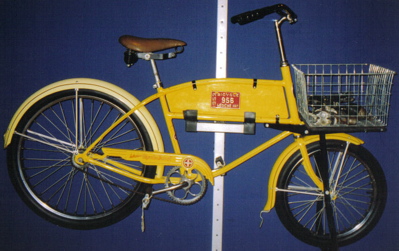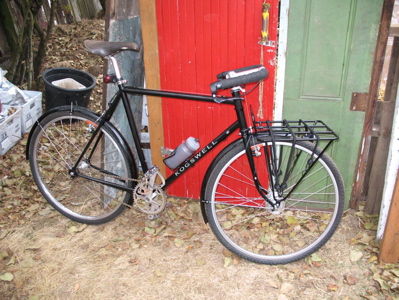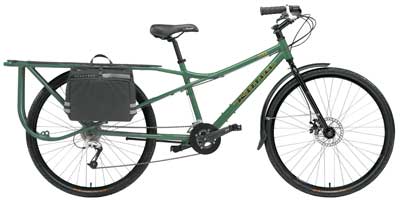Cargo bikes. They’re a big hit with cyclists, and there’s been an industry buzz for them for the past couple years. You know, they’re supposed to allow a cyclist to do carry heavy loads, reduce dependency on the auto, cut down greenhouse gas emissions, allow people in Third World regions to be bring goods to market… maybe even save baby fur seals. But what are they, and do you actually need one?
In Part 1, I first want to tackle the taxonomy of cargo bikes. Right here I’m going to name these bikes so that everyone understands what we’re talking about, before anyone else decides that he’s got a catchy name for something that has existed for decades. And believe me when I say that there is no revolutionary developments in cargo bikes; it’s just the refinement of details that make these new bikes better, more capable, and/or cooler. As such, there are names that are commonly used to describe the different forms of cargo bikes; I didn’t invent any of them. You may have heard of them, or not. Nevertheless, you should adhere to the names I shall now give as if I were Moses descending from the mountain and these monikers inscribed on a fucking stone tablet.
Current rage in cargo bikes centers on longtails: frames that essentially have very long chainstays (let’s say, longer than 60cm where 40-46cm is normal) so that a large payload can be carried behind the rider. Longtails thus have a long wheelbase similar to tandem bikes. Typically, these bikes will ride on 26” mtb wheels or sometimes 700C (29er). As such the load may either fit on either side the rear wheel or on platform above the wheel. Popular examples of this include the Kona Ute, the Yuba, and the Surly Big Dummy. Also, Xtracycle makes a bolt-on unit that converts a standard bike into a longtail.
You probably already knew about longtails, but there is another type of long wheelbase cargo bike.
Hmm, if the load’s not behind the rider, then that means this other type puts the load in front. And you would call this perhaps a “long-front” or “long-nose”?
Absolutely not. The established name for these would be Long John, since that is the name a Danish manufacturer had used for its popular model 70 years ago. Others have copied and perhaps improved on the basic design, so perhaps we should come up with a new general term to replace the branded product name? Again, please refer to fucking stone tablet.

Long Johns have a front wheel (smaller in diameter than the rear) that uses a different steering axis than that of the handlebar; the rider’s steering input is transferred from the handlebar stem axis to the fork via a linkage arm. This allows a long, low platform between the rider and the front fork steerer.
A third variation on the cargo bike is the Truck Cycle/Butcher Bike. These are bikes with a large rack above the front wheel attached to the bicycle frame, as opposed to the fork (which would make them porteur bikes). In the early 20th century, these bikes became closely associated with butchers (especially in Great Britain), but this type of bike was used by people of many different trades to carry goods. Later on the Schwinn company in the states would create a bike with a smaller front wheel so that the rack and its payload would be carried lower, and they called it the Cycle Truck. The British tend to use the term butcher bike rather than cycle truck, and Americans the opposite. For clarification, we’ll say butcher bike when 26” or 700C front wheels are used, and cycle truck when the front wheel is small like 20” (the rear may be regular-sized like the original Schwinn Cycle Trucks or the same smaller size as the front).

Porteur is French term for a bike that had been associated with paper delivery workers in the first half of the 20th century. A large rack was affixed to the fork to carry stacks of newspapers. The line between porteur and “a regular bike with a big ol’basket” is a little vague. Perhaps the nuance lies with the seriousness of the rider’s intent…whether the basket was just a nice accoutrement or something closer to a means of making a living. Further eroding the validity of the porteur nomenclature is the fact that it’s no great feat of engineering to put a big rack on a fork but let’s try to reserve the term for bikes equipped to carry over 15kg on that rack and with geometry optimized for that (mainly more rake on the fork).

Finally, can we put a rack on any bicycle and call it a cargo bike? Um, no. It’s just a bike with rack. Sorry, we can’t all be special. There might be some dissenting opinions but I’ve got this fucking stone tablet to back me up. Remember, I didn’t choose this role, God chose me.
…We're riding townies, adventure, and mountain bikes. Find recommendations on our store page. As Amazon Associates we earn from qualifying purchases.
